Life jackets, often referred to as Personal Flotation Devices (PFDs), are an essential part of water sports equipment.
Whether you’re a beginner or an experienced paddle boarder, having the right life jacket can mean the difference between a great day out on the water and a potentially dangerous situation.
In this article, we’ll review the best life jackets for paddle boarding and provide useful tips for choosing the right one for you.
What is the Best Life Jacket for Paddle Boarding?
It’s difficult to choose a single “best” life jacket for paddleboarding because the best option often depends on the individual’s needs, body type, and the specific conditions they’ll be paddle boarding in.
That being said, the importance of finding a life jacket that fits well, provides excellent buoyancy, and suits your style of paddle boarding cannot be overstated.
Whether you’re embarking on a calm water tour, taking on the waves, or simply enjoying a leisurely day on the lake, there’s a perfect life jacket out there that will help ensure your safety if you are unfortunate enough to find yourself in a dangerous situation and the peace of mind a PDF provides will ultimately enhance your paddle boarding experience.
Now let’s jump into my top 5 picks…
Editors Pick
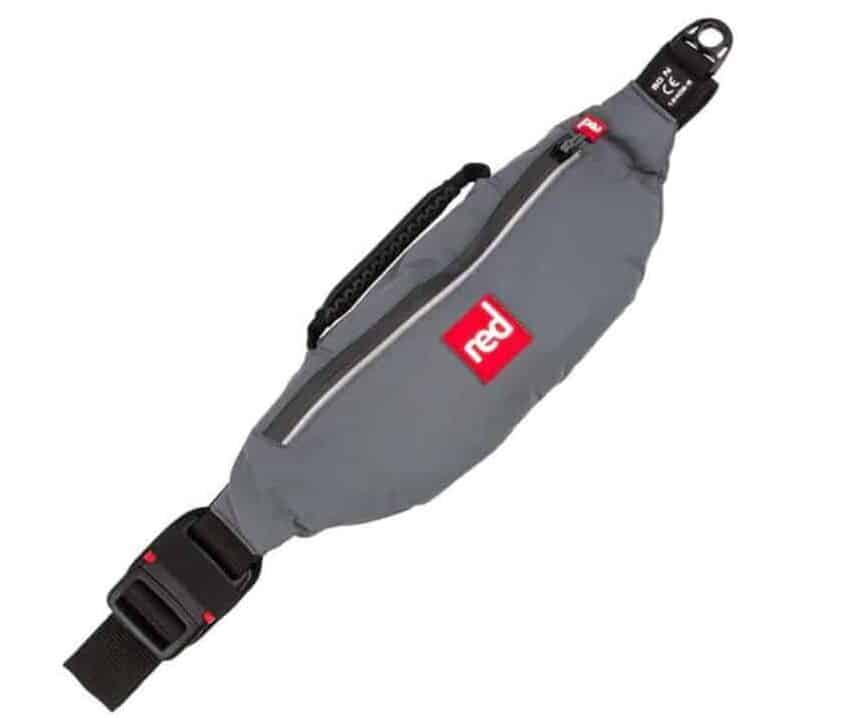
Red Original Airbelt
- Compact and lightweight inflatable PFD belt
- Phone-sized water resistant pocket and D-clips
- 5-year warranty
Best Touring PFD: Yak Xipe PFD
Most Stylish PFD: Jobe 50N Bodywarmer
Best Budget-Friendly Life Jacket: Helly Hansen Rider Vest
Best Budget-Friendly PFD Belt: Spinlock Alto
This article contains affiliate links. If you buy through them, I may earn a commission at no extra cost to you. Learn more here
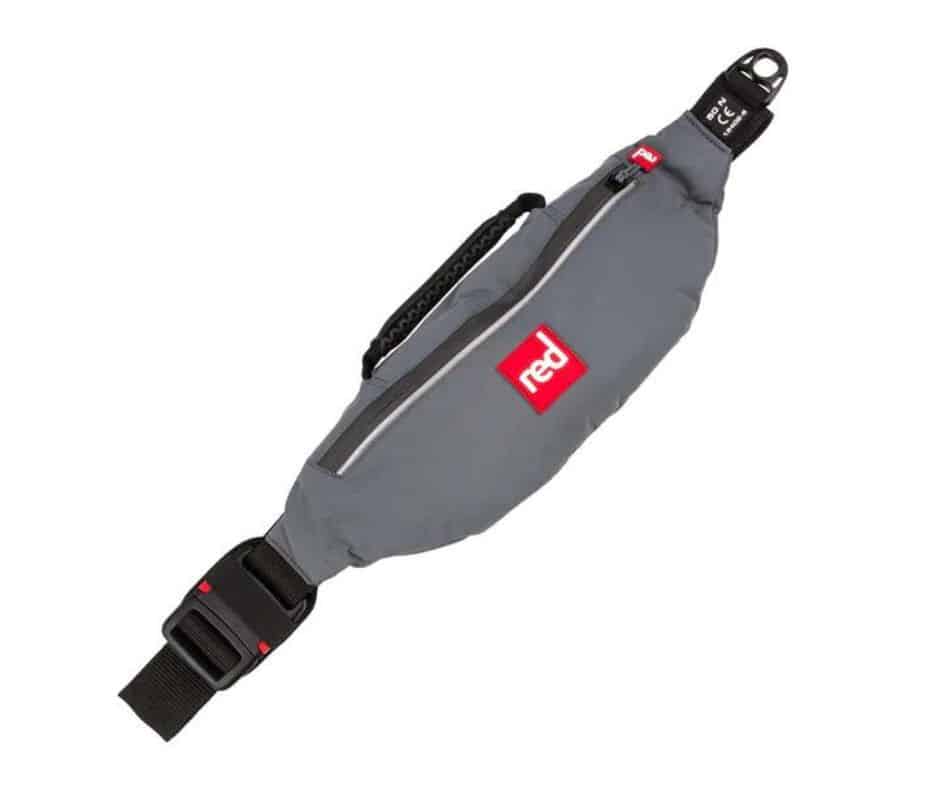
Red Original Airbelt PFD
Editors Pick
The Red Original Airbelt PFD is lightweight and compact, designed to be worn around the waist. This allows for full mobility when standing on the paddle board. Its highlight feature is the air bladder, which remains deflated in the pack until needed. In case of an emergency, a swift pull of the cord will trigger its inflation, transforming it into a fully functional 50N personal flotation device.
The belt also features a water-resistant pocket, perfect for storing small essentials, and an adjustable strap to cater to various body sizes. Additionally, it features D-ring attachments and a reflective strip for added visibility on the water. The vest is bright yellow when inflated; however, the pouch itself comes in a variety of colours.
Pros: Feature-rich PFD belt, premium waterproof fabric, 5-year warranty
Cons: Higher cost when compared to other non-inflatable PFDs
Overall, the Red Original Airbelt PFD is a standout choice for paddle boarders valuing comfort and security, all packed neatly into an unobtrusive belt. Its innovative design, functionality, and convenience make it a premium option for both casual and avid paddle boarders alike.
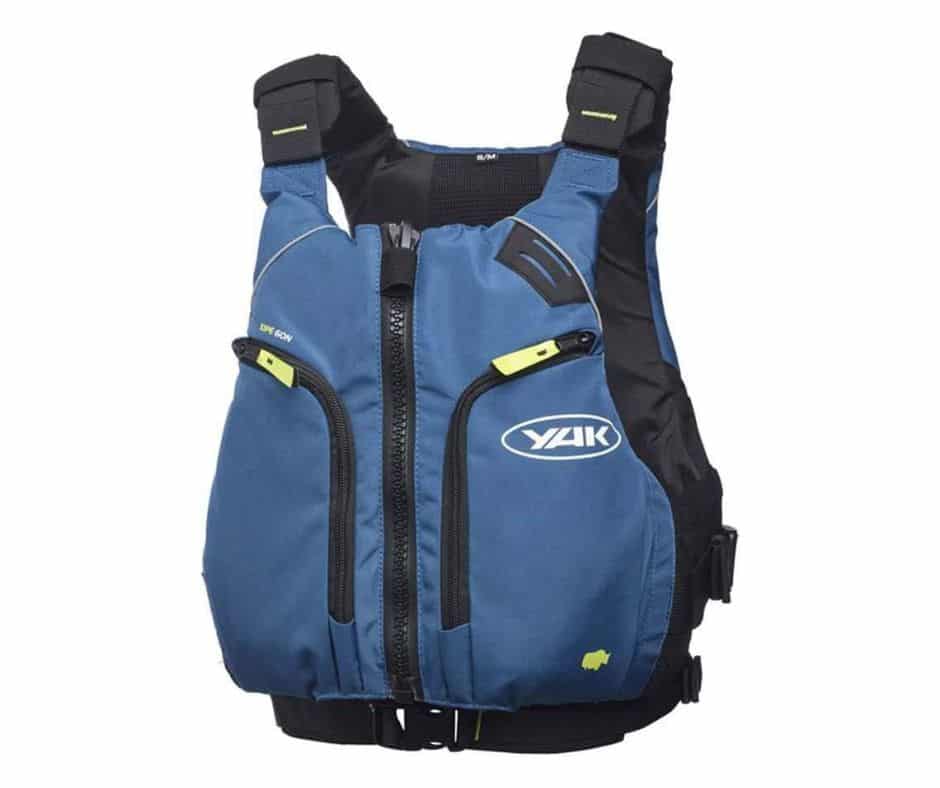
Yak Xipe 60N Buoyancy Aid
Best Touring PFD
The Yak Xipe 60N Buoyancy Aid is a feature-rich life jacket that’s perfect for touring on a paddle board. It features high-density foam for buoyancy and a slim, high-cut design, ensuring optimal mobility on the board.
The front zipper and adjustable straps offer a secure, personalized fit to prevent jacket ride-up. Additionally, it includes a hydration pack pocket, zippered front pockets, and internal mesh pockets, adding convenience for longer paddling sessions as well as reflective detailing for increased visibility.
Pros: Hydration pocket plus lots of other useful pockets, comfortable fit
Cons: Lacks a little in style, not very lightweight
Overall, the Yak Xipe 60N Buoyancy Aid provides excellent comfort, buoyancy, and useful features, making it an exceptional choice for any paddle boarder.
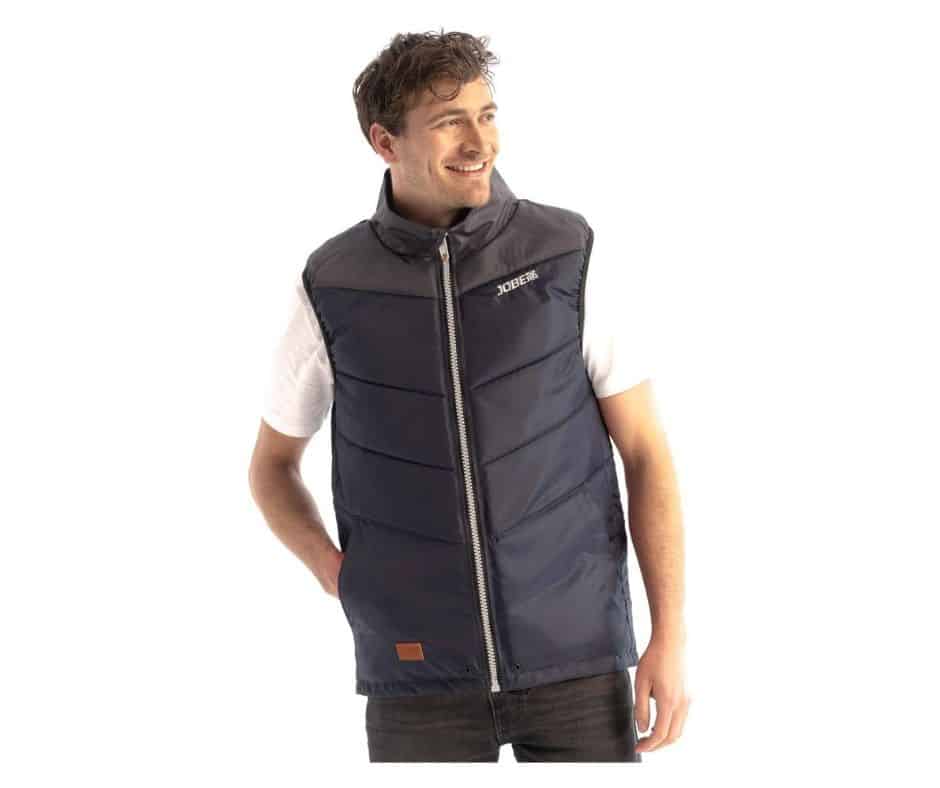
Jobe 50N Bodywarmer
Most Stylish PFD
The Jobe 50 Newton Bodywarmer is an innovative product that combines the safety of a life jacket with the warmth of a body warmer. It’s designed with a minimal bulk structure, allowing for maximum freedom of movement while paddling.
Made from strong, lightweight nylon, it provides excellent durability. Despite its slim fit, it offers 50 Newtons of buoyancy, making it a reliable safety measure for any paddle boarding adventure.
One of the standout features of this life jacket is its quick-entry front zip and inner pocket. It provides the perfect spot to keep small items like keys or a phone safe and within easy reach. In addition, it has a D-ring to attach a safety line and a well-designed water drainage system.
Pros: Very stylish, slim design, water drainage system, two inner pockets
Cons: Far too warm to use on hot summer days
Overall, the Jobe 50 Newton Bodywarmer stands out for its unique blend of warmth, safety, and style. Its comfortable design and ample buoyancy make it an excellent choice for those who paddle board in chillier conditions. Jobe couldn’t have said it better when they said, “Being stylish has never been so safe!”
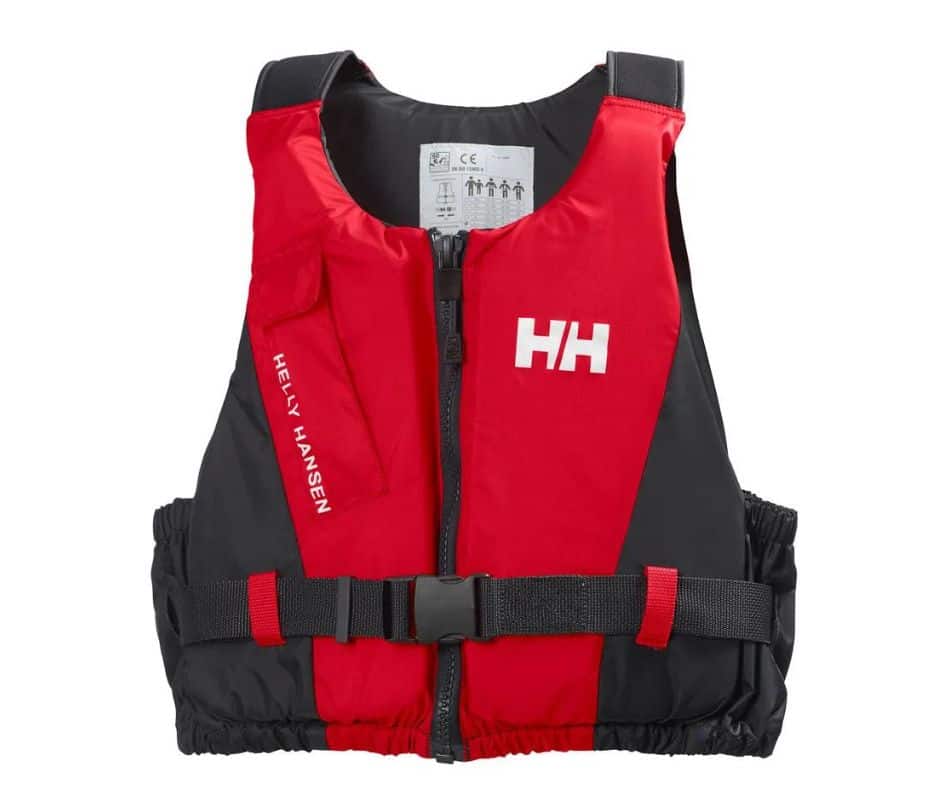
Helly Hansen Rider Vest
Best Budget-Friendly Life Jacket
The Helly Hansen Rider Vest is a fantastic option for paddle boarders prioritizing safety and comfort. This Type III life vest offers 50N buoyancy and is low bulk, making it a popular choice for a wide variety of watersports.
Featuring a zippered front and wide armholes, it allows for a wide range of motion, which is crucial for paddle boarding. It also boasts reflective elements for improved visibility, enhancing safety during low-light conditions. Another unique feature of this jacket is its front flare pocket.
Pros: Bulk-free jacket, lightweight and comfortable, soft foam front panels
Cons: Other than the front flare pocket, this vest lacks any other pockets
Overall, the Helly Hansen Rider Vest offers a superb balance of safety, comfort, and flexibility. Its reflective elements and optimal buoyancy make it a fantastic choice for paddleboarders who like to hit the water at different times of the day.

Spinlock Alto Belt Pack
Best Budget-Friendly PFD Belt
For paddle boarders looking for a compact, unobtrusive buoyancy aid, the Spinlock Alto Belt Pack is a perfect choice. Designed as a belt pack, this type III flotation device can be worn on the front or back, which is fantastic as it doesn’t inhibit your movement or cause discomfort, allowing for an enjoyable paddle boarding experience.
When deflated, it’s small and very light, weighing just 376 grams; it’s barely noticeable as you stand up paddle around on your board. It’s worth noting that this buoyancy aid is manually activated, which is achieved via a pull of a toggle on the belt.
Pros: Light and compact, 75N of emergency buoyancy, available in a range of stylish colours
Cons: Manual inflation only, not suitable for weak swimmers
Overall, the Spinlock Alto Belt Pack is an excellent option for paddle boarders who want maximum mobility without compromising on safety. Its lightweight and compact design makes it an ideal choice for those seeking a less restrictive, yet highly effective, life jacket.

Palm Meander PFD
This buoyancy aid is designed with both comfort and functionality in mind. The Palm Meander has a low-profile design and a shape that is body-hugging, making it ideal for a wide range of paddle sports.
It features soft foam for additional comfort and adjustable shoulder straps plus 3D anti-ride-up waist belt to ensure a secure fit. This buoyancy aid also boasts a large front pocket (not waterproof) that’s perfect for storing small essentials while you’re out on the water.
The Palm Meander comes in a variety of sizes to cater to different body types. Whether you’re a slim paddler or on the larger side, you’re likely to find a size that fits you perfectly. It’s also suitable for both men and women, making it a versatile choice for paddle boarders.
Pros: High-quality materials, adjustable straps for a custom fit, comfortable for long periods of use, reflective strips
Cons: Honestly, couldn’t find anything!
Overall, the Palm Meander buoyancy aid is a reliable choice for paddle boarders of all levels. It delivers on comfort, has a secure fit, and comes with handy storage, ensuring a positive paddle boarding experience.
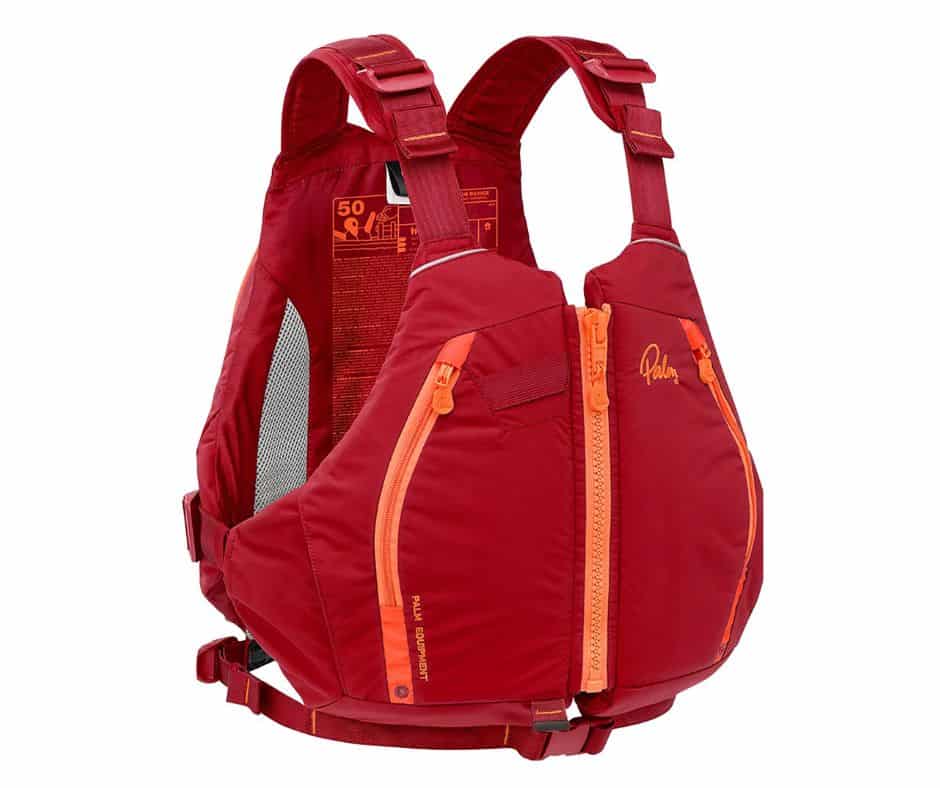
Palm Peyto
The Palm Peyto Touring buoyancy aid is another excellent choice for paddle boarders, described by Palm as a premium all-season PFD. With its adjustable shoulder and waist straps, it offers a customizable fit, ensuring comfort and security while on the water.
One of its unique features is the built-in hydration pack pocket, perfect for longer paddleboarding sessions. It also has large zipped front pockets for keeping essentials within reach and hidden hand warmers too.
Furthermore, Palm offers a variation of this vest with a specialized fit tailored specifically for women.
Pros: Stylish personal flotation device comes in a variety of colours and women-specific fit, hand warmers, spacious pockets, and a hydration pouch.
Cons: Higher price point compared to others on this list
Overall, the Palm Peyto Touring buoyancy aid is a highly versatile option for paddle boarders, with its adjustable fit and rear hydration pocket. Whether you’re on a short trip or an all-day adventure, this life jacket has got you.
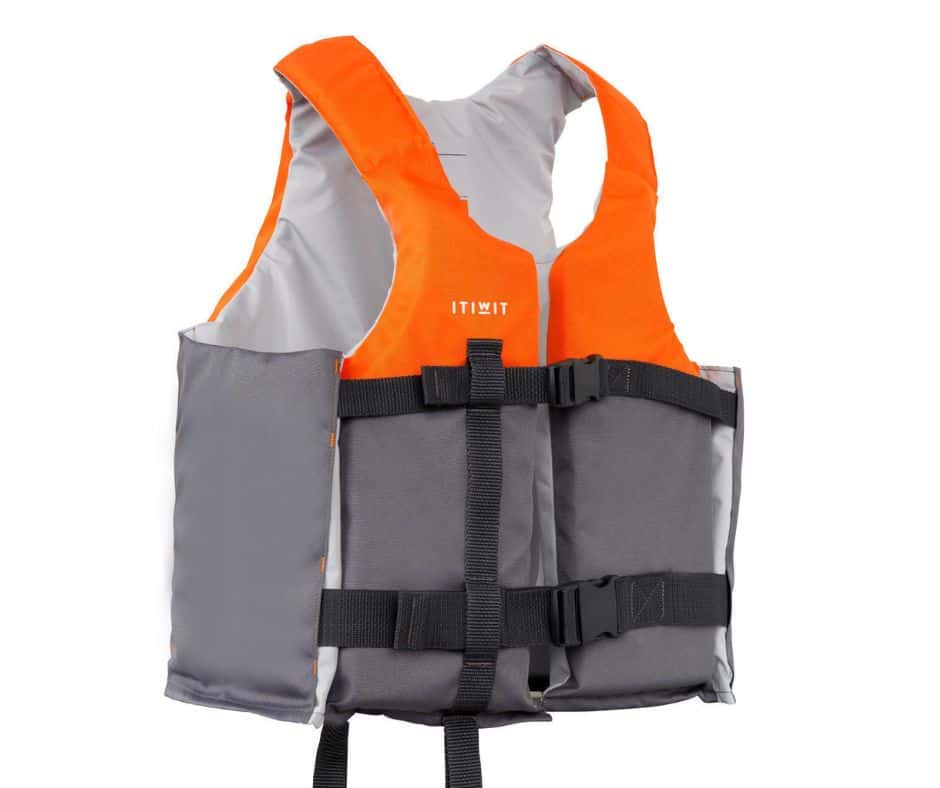
Decathlon Itiwit 50N+ Buoyancy Aid
Decathlon’s Itiwit 50N+ buoyancy aid is a testament to simplicity and functionality. Designed specifically for paddle sports, it features a streamlined shape that reduces the bulk and allows for unrestricted movement, plus it won’t cost you a fortune making it a perfect choice for anyone just getting started.
The Itiwit 50N+ features an adjustable strap system including a crotch strap that guarantees a snug fit regardless of body shape. But perhaps the standout feature is its 70N buoyancy, offering adequate floatation without compromising on comfort and price.
Pros: Simple but effective 70N PFD, Perfect for beginners and budget-conscious paddlers, 2-year warranty
Cons: Lacks some basic features such as pockets
Overall, the Decathlon Itiwit 50N+ buoyancy aid is an affordable and reliable option for both beginner and experienced paddle boarders. Its combination of comfort and adjustability make it a solid choice for anyone on a budget.

Palm Glide Inflatable PFD
The Palm Glide inflatable PFD belt provides excellent buoyancy, 100N worth to be precise, which can be inflated in seconds with a quick pull of a cord. The belt is equipped with a buckle closure system, which ensures a secure fit for paddle boarders.
The inflatable PFD has a useful zippered pocket large enough for a mobile phone and includes 2 D-clip points, adding to its functionality. The Palm Glide is barely noticeable whilst paddling, but once inflated, it slips easily over the head and fastens securely.
Pros: Handy pockets and D-clips, 100N buoyancy, and barely noticeable when paddling
Cons: CO₂ refills are expensive and sold separately
Overall, the Palm Glide PFD impresses with its 100N buoyancy, comfort, secure fit, and thoughtful design. It’s a brilliant choice for paddle boarders seeking a life jacket that offers both freedom of movement and reliable safety features.
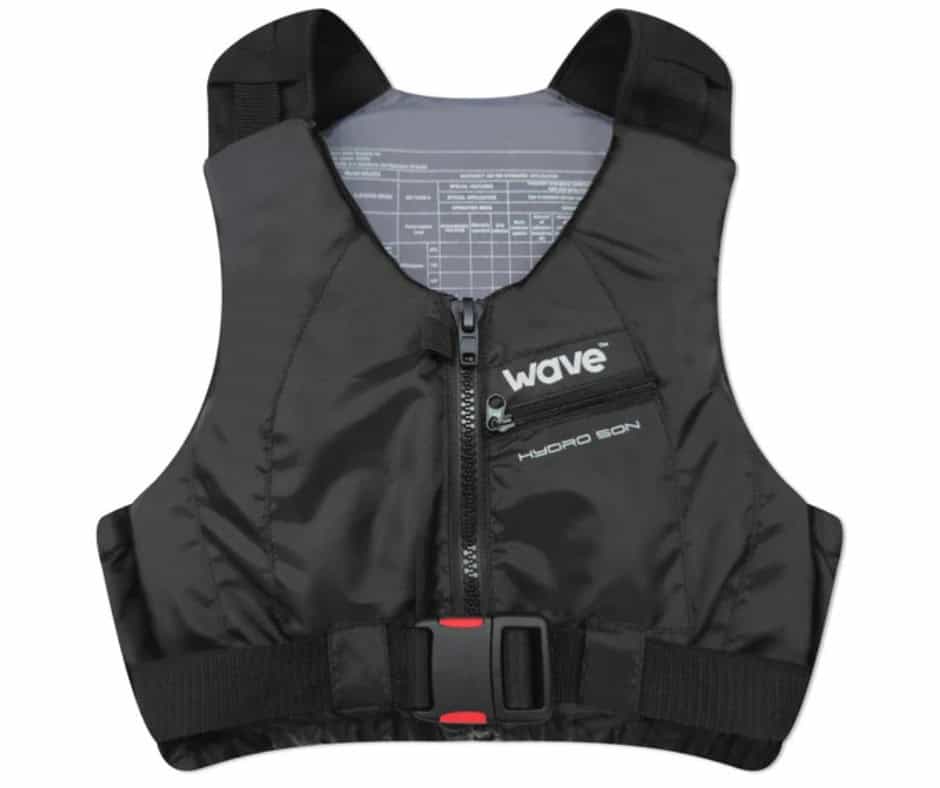
Wave Buoyancy Aid
The Wave Buoyancy Aid is a sleek, minimalist PFD designed specifically for paddle boarders who value freedom of movement. This black buoyancy aid features a streamlined profile that won’t restrict your paddling technique while providing reliable flotation when you need it most.
Constructed with high-quality materials, the Wave Buoyancy Aid includes multiple adjustment points to ensure a secure, comfortable fit across different body types. The design incorporates a safety whistle and reflective elements for enhanced visibility on the water, making it an excellent choice for both recreational paddlers and those venturing into more challenging conditions.
Pros: Clean, unobtrusive design, small front pocket, includes safety whistle, quick release buckle
Cons: Limited storage options, minimal additional features compared to touring-focused PFDs
Overall, the Wave Buoyancy Aid delivers essential safety features in a no-nonsense package that’s perfect for paddle boarders who prefer a streamlined approach to water safety. Its focus on core functionality and comfort makes it an excellent choice for those who want reliable buoyancy without unnecessary bulk.
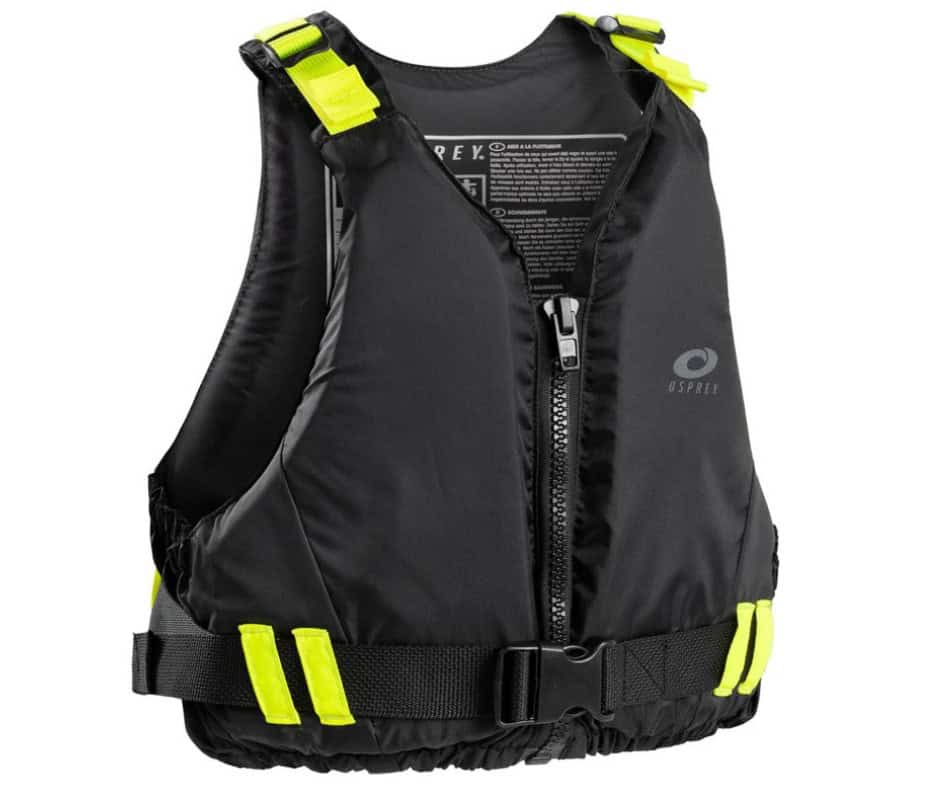
Osprey Buoyancy Aid 50N
The Osprey Buoyancy Aid 50N is a fully certified buoyancy jacket that combines safety, comfort, and visibility in one well-designed package. This slimline PFD offers 50N of buoyancy while maintaining a body-hugging profile that allows for complete freedom of movement during paddling.
Built with durable materials to withstand regular water activities, the Osprey features adjustable shoulder and waist straps for a customized fit. The standout feature is its high-visibility yellow straps that enhance your safety profile on the water, while the robust YKK front zip and oversized front buckle ensure secure closure even in challenging conditions.
Pros: ISO certified for peace of mind, high-visibility safety features, robust YKK hardware
Cons: Limited storage options, may be too basic for touring enthusiasts seeking extra features
Overall, the Osprey Buoyancy Aid 50N is a solid, no-frills choice for paddle boarders who want certified safety equipment that won’t break the bank. Its combination of proper certification, visibility features, and durable construction makes it a reliable option for recreational paddlers across all skill levels.
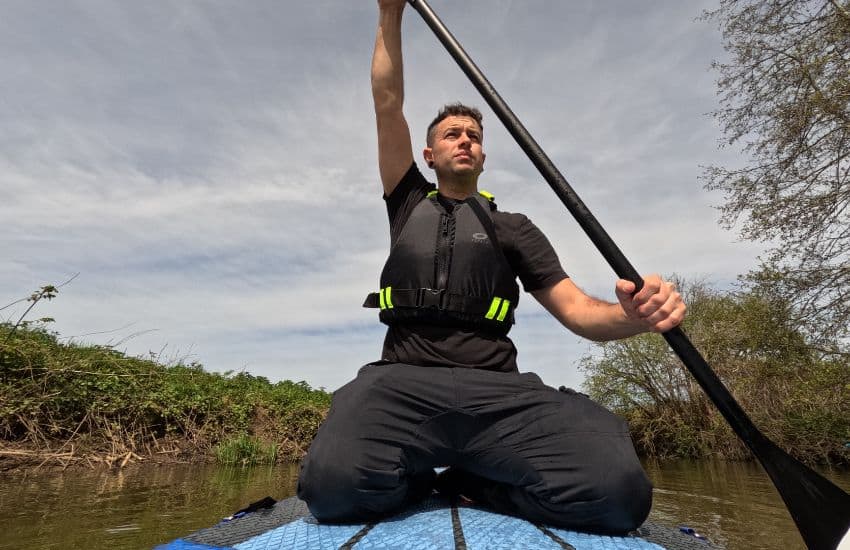
Factors to Consider When Choosing a Paddle Board Life Jacket
Now that we’ve explored my top life jacket picks for paddle boarding, let’s discuss the essential factors you need to consider when choosing the perfect PFD for your paddle boarding adventures.
Fit
The life jacket should fit snugly around your chest and waist, but not so tightly that it restricts your movement or breathing. Most life jackets have adjustable straps that can be tweaked to achieve a secure fit. Some are designed specifically for a female figure, offering a better fit around the chest and waist. It’s essential to check the manufacturer’s size guide before purchasing and try on the jacket if possible.
Comfort
A comfortable life jacket makes for a more enjoyable time on the water. Look for life vests and jackets with soft foam inserts, adjustable straps, mesh panels for maximum airflow, and padded shoulder straps for added comfort. The foam should not dig into your skin, and you should barely notice the shoulder straps while paddling.
Buoyancy
Buoyancy is the force that keeps you afloat in the water, and it is measured in Newtons. The correct amount of buoyancy in a life jacket is dependent on your body weight, the water conditions, and your swimming ability. Generally, heavier individuals and weak swimmers require more buoyancy.
Design
Life jackets come in various designs, such as vest-style life jackets, inflatable life jackets, and belt packs. Vest-style life jackets typically have a foam core for buoyancy and are very reliable, while inflatable life jackets are compact and comfortable but must be inflated to provide buoyancy. Belt packs are slim and lightweight, but they also need to be inflated and then manually pulled over your head for proper use.
Features
Look for additional features like zippered pockets for storing small items, reflective accents for increased visibility, and a whistle for attracting attention. A life jacket with a hydration pack might also be beneficial for long paddleboarding sessions.
Safety Certification
In the United States, life jackets should be United States Coast Guard (USCG) approved. This certification indicates that the life jacket meets stringent safety standards and is deemed safe for use in watersports. Other countries may have different regulatory bodies, but always ensure your jacket is certified by an authoritative agency.
Materials and Durability
Life jackets made with durable materials will withstand wear and tear better, particularly in saltwater and intense sunlight conditions. Nylon is a common material due to its durability and affordability, while neoprene is more flexible and comfortable but also more expensive.
Environmental Suitability
Consider where you will be paddle boarding. If you’re paddle boarding on a calm body of water under the sun, a life jacket with good ventilation is essential. For rougher, colder water conditions, a life jacket that provides better coverage and buoyancy is important.
Remember, the best paddle boarding life jacket is the one that fits you well, is comfortable to wear, and meets all safety requirements. It’s always a good idea to try on several options before making a decision.
Related Article: What To Wear Paddle Boarding: The Essential Guide

Understanding Life Jacket Types
Life jackets or Personal Flotation Devices (PFDs) come in several types, each with its unique features, intended uses, and performance ratings.
Here, we’ll break down the most common types of PFDs to help you determine which might be the best life jacket for your paddleboarding needs:
Type I PFD (Off-Shore Life Jacket)
Type I PFDs are designed for rough, open waters where rescue may be delayed. They offer the most buoyancy and are designed to turn most unconscious wearers face up in the water. However, they are generally bulkier and not as comfortable for recreational activities like paddle boarding.
Type II PFD (Near-Shore Buoyant Vest)
Type II PFDs are intended for calm inland waters, where fast rescue is likely. They are less bulky than Type I PFDs and are more comfortable to wear, but may not turn an unconscious wearer face up in the water.
Type III PFD (Flotation Aid)
A type III life jacket is the most common for paddle boarding and other water sports. They are designed for conscious wearers in calm water, are very comfortable, and allow for a wide range of movement. However, they may not turn an unconscious wearer’s face up.
Type IV PFD (Throwable Device)
Type IV PFDs are devices designed to be thrown to a person in the water and are not intended for paddle boarders to wear.
Type V PFD (Special Use Devices)
Type V PFDs are designed for specific activities like kayaking, waterskiing, or windsurfing. To be effective, they must be used for the activity they’re designed for. Some Type V PFDs are also inflatable.
In the realm of paddle boarding, Type III life jackets are the most common choice for paddle boarding adventures due to their combination of safety features and comfort.
Designed to keep the wearer upright and face-up in calm water, they allow a great deal of movement which is particularly important for paddle boarders. These jackets are typically equipped with foam for buoyancy and come in a variety of shapes, sizes, and styles to cater to different body types and personal preferences.
From vest-style jackets to lighter, belt-pack styles, Type III life jackets offer both security and comfort for an enjoyable paddle boarding experience.
In addition to these, Inflatable PFDs are becoming more popular for sports like paddle boarding. They’re compact and comfortable, inflating manually with a pull cord or they inflate automatically upon immersion.
It’s worth mentioning that in the United States, any PFD used must be United States Coast Guard (USCG) approved. The approval indicates that the life jacket meets stringent safety standards and is deemed safe for use in water sports.
Knowing the type of life jacket can help you make an informed decision based on the nature of your paddle boarding activity, your swimming skills, and the specific conditions where you’ll be paddle boarding. Safety should always be your top priority. So make sure to wear a life jacket that’s right for you.

Finding the Right Size and How to Fit a PFD
Finding a comfortable life jacket with the right fit is crucial for ensuring it works properly in the water and is comfortable enough to wear throughout your paddle boarding adventures. Here are some guidelines to help you find the right size and fit your paddle board PFD:
Understand PFD Sizing
PFDs aren’t sized like regular clothing, and one size definitely does not fit all. Instead, PFD sizes are based on body weight and chest measurements. Adult PFDs are generally categorized into three sizes: Small, Medium, and Large, with each category accommodating a range of chest sizes.
For children’s PFDs, sizing is often based on weight. Always check the manufacturer’s size guide to determine the appropriate size for you or your child.
Measure Your Chest
To get the most accurate measurement, use a flexible tape measure. Wrap the tape around the fullest part of your chest, under your arms, and across your shoulder blades. This measurement is your chest size. Remember, PFD sizing is different from clothing sizing, so always refer to the manufacturer’s size chart.
Try It On
This is the best way to ensure a proper fit. The life jacket should fit snugly but allow enough room for you to move freely. Make sure to adjust all straps for a secure fit. Check that the PFD doesn’t rise above your chin or face when you lift your arms above your head. This is called a ‘fit test,’ and it’s crucial for ensuring the life jacket will not slip off in the water.
Check for Comfort
Once your PFD is on, check for any points of discomfort. Are the armholes big enough? Is the foam causing any discomfort? Can you breathe easily? If you’re comfortable, you’re more likely to wear a life jacket, which is the whole point.
Customize the Fit
Most PFDs come with adjustable straps that allow you to customize the fit. These are usually located at the sides or front of the PFD. To adjust, loosen the straps, put the PFD on, zip it up, and then gradually tighten the straps until the PFD fits snugly but comfortably.
Do the Final Check
Ask someone to pull up the PFD by the shoulders. If it moves significantly, it’s too loose. If you’re having trouble breathing or the PFD is causing discomfort, it’s too tight. Adjust accordingly until you find the right fit.
By following these steps, you can ensure that your life jacket will stay securely in place, keep you afloat, and provide maximum comfort during your SUP session. And remember, the most important rule when it comes to life jackets is to always wear it. A life jacket can only save your life if you’re wearing it.
Do You Need to Wear a Life Jacket While Paddle Boarding?
In the UK, there are no specific laws that mandate the wearing of a life jacket or Personal Flotation Device (PFD) while paddle boarding. However, the Royal National Lifeboat Institution (RNLI) strongly recommends wearing a suitable PFD for safety.
Paddle boarding is considered a safe sport but the water can be unpredictable, and even the most experienced paddle boarders can find themselves in the water unexpectedly; therefore, as a beginner who is first learning how to paddle board, a PFD is especially important for those who lack confidence in the water. A life jacket can provide the necessary buoyancy to keep you afloat, especially if you’re a weak swimmer or the water is cold.
It’s also important to note that some bodies of water in the UK may have their own specific rules regarding life jackets, so it’s always a good idea to check local regulations.
However, if you’re reading this article in the United States, the regulations around wearing a life jacket while paddle boarding are a bit more strict. According to the United States Coast Guard (USCG), paddle boards are classified as vessels, which means that if you’re beyond the limits of a swimming, surfing, or bathing area, you must have a USCG-approved life jacket onboard.
Children under 13 must wear a USCG-approved life jacket at all times while on a paddleboard. Adults are not required to wear a life jacket, but it must be readily accessible on the paddle board.
Despite the differing regulations, both in the UK and the US, it is universally agreed that wearing a life jacket while paddle boarding significantly enhances your safety.
Life Jackets for Kids

When it comes to ensuring the safety of children on the water, choosing the right life jacket is paramount. Unlike adult jackets, kids’ life jackets are typically classified based on weight rather than chest or waist size. It’s essential to check the manufacturer’s specifications to make sure you have the correct fit. A well-fitted life jacket should feel snug but not restrict a child’s movements.
Comfort is another important factor. Kids are more likely to willingly wear their life jackets if they are comfortable and visually appealing. Selecting a jacket in their favourite colour or adorned with characters from their favourite show might make them more enthusiastic about wearing it.
Additional safety features are also crucial. Look for jackets that have a grab handle, which allows an adult to quickly pull a child from the water, and a crotch strap to prevent the jacket from slipping off.
My boys wear the Osprey Junior Buoyancy Aid when we’re out on the water, and it’s been a great choice, comfortable, and designed with all the key safety features in mind. Plus, it’s available in a variety of bright colour options, meaning I can easily spot them running around on the beach.
Life Jackets for Dogs

Even dogs, our faithful companions, deserve to be safe and comfortable when joining in on paddle boarding adventures. Dogs, like humans, can get exhausted in the water, and not all breeds are naturally good swimmers. A dog life jacket provides your furry friend with extra buoyancy and visibility in the water.
When choosing a life jacket for your dog, consider the fit, buoyancy, and comfort. The jacket should fit properly and snugly around your dog’s body and not interfere with their ability to move or swim. Most dog life jackets come with adjustable straps for a secure fit. Additionally, the jacket should have enough buoyancy to keep your dog afloat in the water.
Lastly, comfort is a significant factor. The life jacket should be made from comfortable materials that won’t chafe your dog’s skin. Some dog life jackets also come with convenient features like a grab handle for easy rescue and reflective strips for increased visibility. In essence, a dog life jacket should ensure your pup’s safety while letting them enjoy the water.
Final Thoughts
Finding the best paddle boarding life jacket requires careful consideration of factors such as type, fit, and comfort, as well as the specific requirements of the wearer, whether they’re adults, kids, or even our four-legged friends.
While regulations for recreational paddling may differ from the UK to the US, one thing is universally agreed upon – the importance of wearing a life jacket can’t be overstated. It’s not just about complying with regulations; it’s about ensuring maximum safety while enjoying your paddleboarding adventures.
The paddle board life jackets I reviewed today, from brands like Palm Meander, Jobe, Decathlon Itiwit, Spinlock, Helly Hansen, and Red Original, offer a range of options to suit a variety of needs and preferences.
Whether you’re just getting started, learning how to paddleboard for the first time, or are an experienced paddleboarder, these life jackets deliver in terms of safety, comfort, and style.
I hope this guide has provided you with valuable insights and will help you make a more informed decision when purchasing your next life jacket for paddle boarding.
Remember, the best life jacket is the one you will wear. So choose wisely, stay safe, grab your SUP, and enjoy the thrill of paddle boarding!
Best Life Jacket for Paddle Boarding FAQ
What is the difference between a PFD and a life jacket?
While the terms Personal Flotation Device (PFD) and life jacket are often used interchangeably, they do have distinct differences. A life jacket is designed to turn an unconscious person face up in the water, providing more buoyancy. A PFD, on the other hand, is intended to keep a conscious person afloat in the water and may not turn an unconscious person face up.
Do you need a life jacket on a paddleboard?
Yes, it is highly recommended and is the law in many places, including the US. The U.S. Coast Guard classifies paddle boards as vessels, so a USCG-approved life jacket must be available for each person on the paddle board.
What life jacket do I need for paddle boarding?
A Type III life jacket, or PFD, is often recommended for paddle boarding due to its combination of buoyancy and comfort. It provides sufficient flotation while allowing for the mobility that paddle boarders need.
How much buoyancy do I need in a life jacket?
The buoyancy you need in a life jacket is directly related to your body weight and the conditions in which you’ll be paddleboarding. In general, you need at least 7-12 pounds of buoyancy for adults. However, always consult with a professional or the life jacket’s manufacturer to ensure it’s suitable for your specific needs.
What is the best type of buoyancy aid for paddle boarding?
A Type III life jacket or PFD is often considered the best type of buoyancy aid for paddle boarding. They offer a good balance between buoyancy and freedom of movement.
Does a PFD offer more protection than a life jacket?
A PFD and a life jacket offer different types of protection. A life jacket is designed to turn an unconscious person face-up in water, offering more life-saving buoyancy. A PFD is designed to keep a conscious person afloat. It may not turn an unconscious person face-up, but it often offers more comfort and mobility, making it a popular choice for conscious water sports enthusiasts.

About the Author
Steve Cleverdon is an outdoor adventure specialist with 15+ years of hiking, camping, and paddle boarding experience. He has conquered Europe’s toughest trails including the GR20 in Corsica, walked 3,000km solo across New Zealand, and worked professionally in the outdoors industry. Steve’s gear reviews and recommendations are based on real-world testing across four continents, from coastal waters to mountain peaks. Learn more about Steve or get in touch.